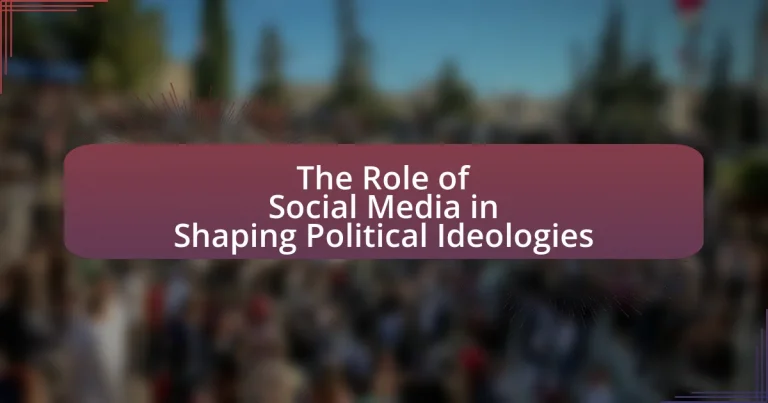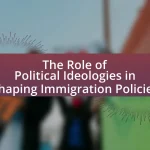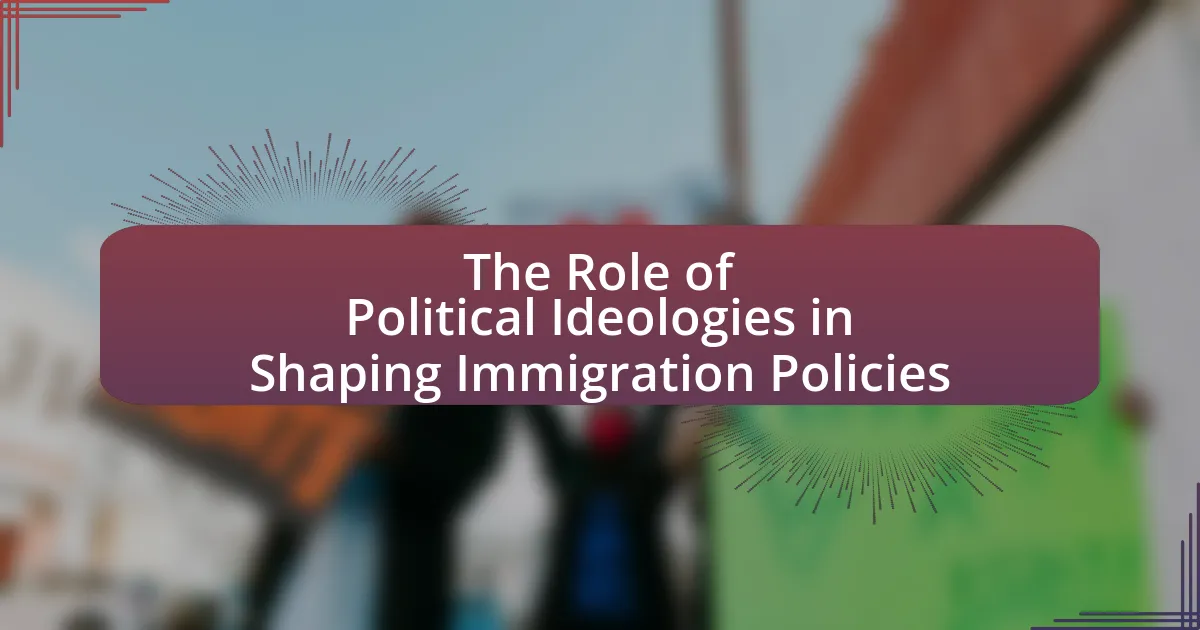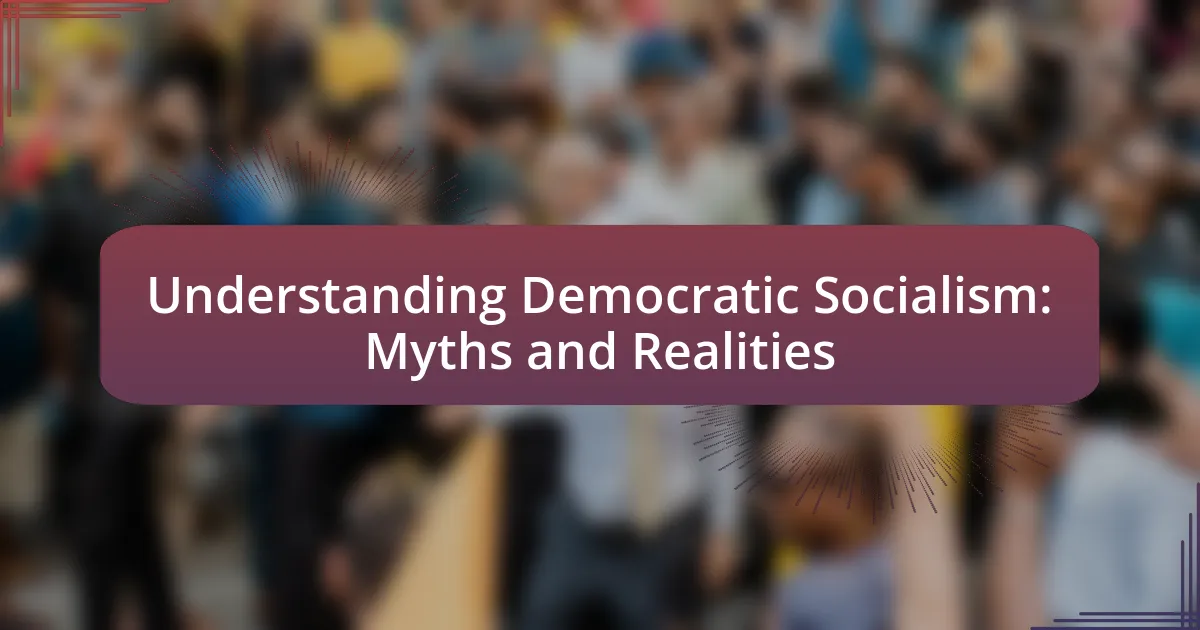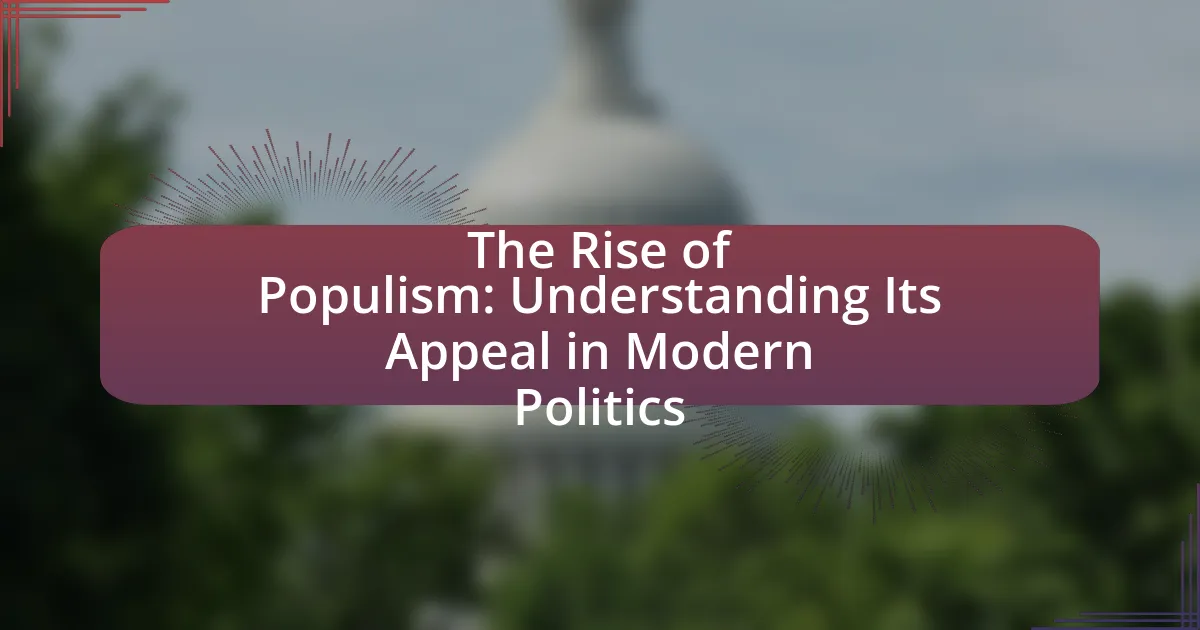The article examines the significant role of social media in shaping political ideologies, highlighting how platforms like Twitter and Facebook facilitate the rapid dissemination of information and user engagement. It discusses the transformation of political discourse through real-time communication, the impact of algorithms on content visibility, and the creation of echo chambers that reinforce existing beliefs. Key features of social media, such as user-generated content and algorithm-driven personalization, are analyzed for their influence on political polarization and mobilization. The article also addresses the challenges posed by misinformation and the implications for democratic processes, emphasizing the need for media literacy and respectful discourse to foster healthy political engagement.
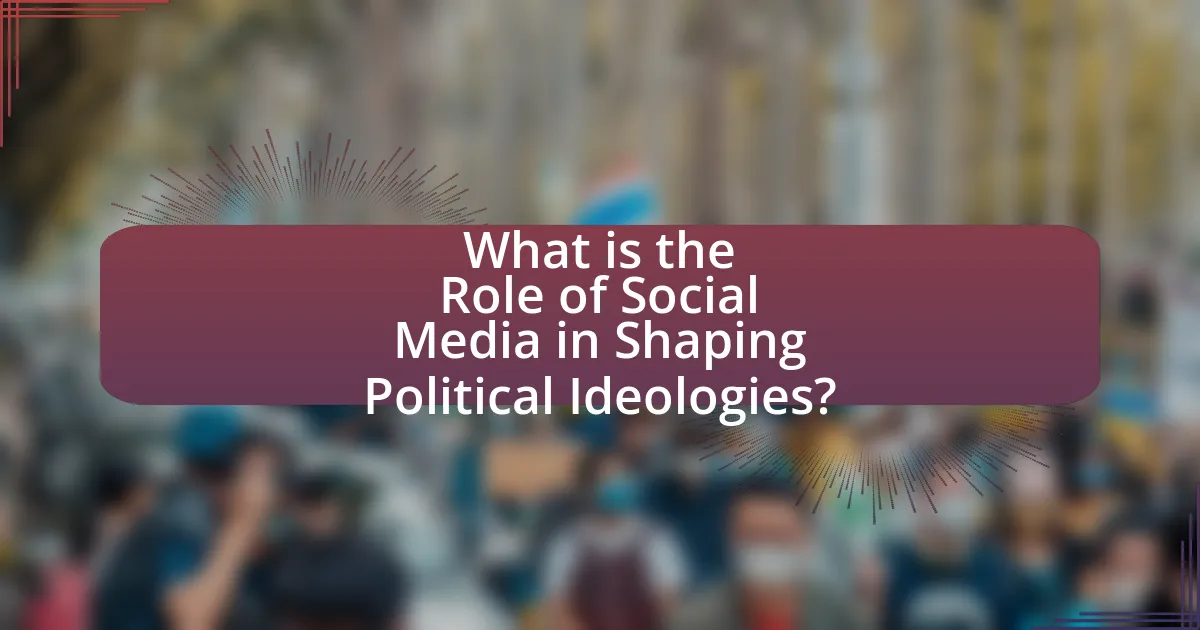
What is the Role of Social Media in Shaping Political Ideologies?
Social media plays a crucial role in shaping political ideologies by facilitating the rapid dissemination of information and enabling user engagement. Platforms like Twitter and Facebook allow individuals to share opinions, mobilize support, and create echo chambers that reinforce specific beliefs. Research indicates that social media can influence political polarization; for instance, a study by the Pew Research Center found that 62% of Americans get news from social media, which often presents biased perspectives that align with users’ pre-existing views. This environment fosters ideological alignment and can lead to the radicalization of opinions, as users are exposed primarily to content that resonates with their beliefs, thereby shaping their political ideologies significantly.
How has social media transformed political discourse?
Social media has transformed political discourse by enabling real-time communication and engagement between politicians and the public. This shift allows for immediate feedback and interaction, which contrasts with traditional media’s one-way communication model. For instance, platforms like Twitter and Facebook facilitate direct dialogue, allowing politicians to respond to public concerns swiftly and enabling citizens to express their opinions widely. According to a Pew Research Center study, 69% of adults in the U.S. use social media, which underscores its role in shaping political conversations and mobilizing grassroots movements. This transformation has led to increased political polarization, as algorithms often promote echo chambers, reinforcing existing beliefs rather than fostering diverse viewpoints.
What are the key features of social media that influence political ideologies?
Key features of social media that influence political ideologies include user-generated content, algorithm-driven personalization, and the rapid dissemination of information. User-generated content allows individuals to express their political views and share information, which can shape public opinion and mobilize support for specific ideologies. Algorithm-driven personalization tailors content to users’ preferences, reinforcing existing beliefs and creating echo chambers that limit exposure to diverse perspectives. The rapid dissemination of information enables swift spread of political messages, which can amplify movements and influence voter behavior. Research by the Pew Research Center indicates that social media platforms significantly impact political engagement and ideology formation, highlighting their role in modern political discourse.
How do algorithms affect the visibility of political content?
Algorithms significantly influence the visibility of political content by determining which posts are prioritized in users’ feeds based on engagement metrics. These algorithms analyze user behavior, such as likes, shares, and comments, to promote content that is likely to resonate with individual users, often amplifying polarizing or sensational material. Research by the Pew Research Center indicates that social media platforms like Facebook and Twitter utilize algorithms that can create echo chambers, where users are predominantly exposed to viewpoints that align with their own, thereby shaping political ideologies and discourse. This selective exposure can lead to increased polarization, as users may become less aware of opposing perspectives.
Why is social media important in modern politics?
Social media is important in modern politics because it serves as a primary platform for communication, engagement, and mobilization among voters and political entities. It allows politicians to directly reach constituents, bypassing traditional media filters, which enhances transparency and fosters real-time interaction. For instance, during the 2016 U.S. presidential election, over 70% of voters reported using social media to follow political news, demonstrating its significant influence on public opinion and voter behavior. Additionally, social media facilitates grassroots movements, as seen with the Arab Spring, where platforms like Twitter and Facebook were instrumental in organizing protests and spreading awareness. This underscores the critical role social media plays in shaping political ideologies and influencing democratic processes.
What role does social media play in political mobilization?
Social media plays a crucial role in political mobilization by facilitating communication, organization, and engagement among individuals and groups. It enables political movements to rapidly disseminate information, rally support, and coordinate actions, as evidenced by events like the Arab Spring, where platforms like Twitter and Facebook were instrumental in organizing protests and spreading awareness. Research indicates that social media can increase political participation; for instance, a study by the Pew Research Center found that 69% of adults in the U.S. use social media, with many reporting that these platforms help them stay informed about political issues and connect with like-minded individuals.
How does social media impact voter engagement and turnout?
Social media significantly enhances voter engagement and turnout by facilitating information dissemination and fostering community interaction. Platforms like Facebook and Twitter allow political campaigns to reach a broader audience, mobilizing supporters through targeted advertisements and grassroots organizing. According to a study by the Pew Research Center, 69% of adults in the U.S. use social media, which has been linked to increased political participation, especially among younger demographics. Furthermore, social media enables real-time communication and mobilization, as evidenced by the 2018 midterm elections, where states with higher social media activity saw increased voter turnout rates.
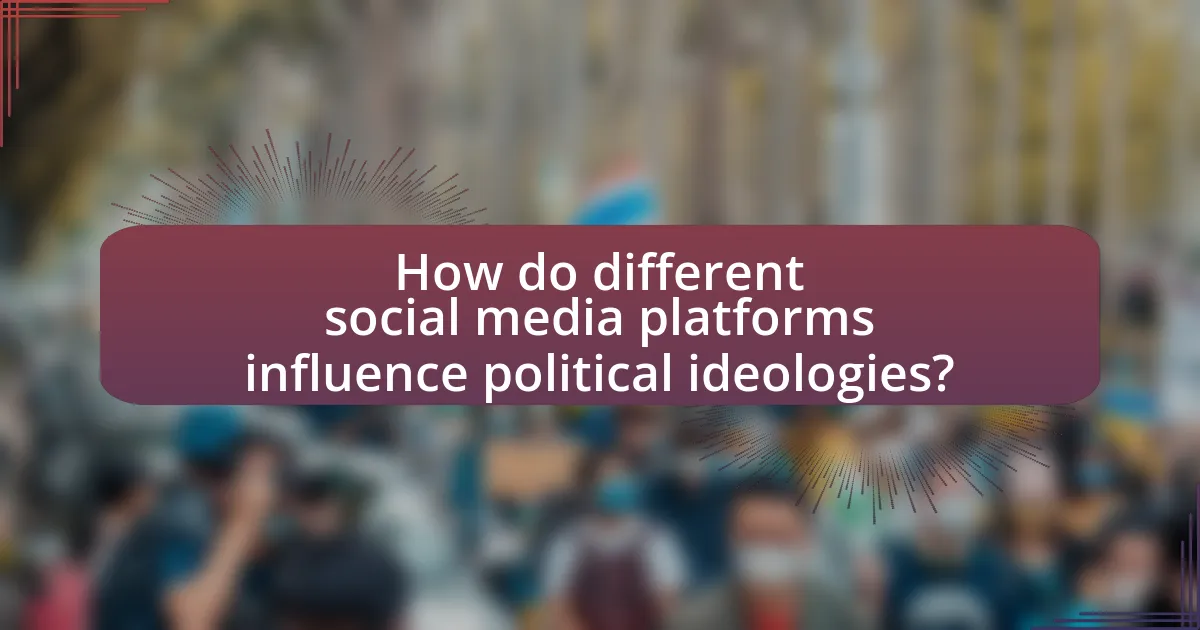
How do different social media platforms influence political ideologies?
Different social media platforms influence political ideologies by shaping the way information is disseminated and consumed. For instance, platforms like Facebook and Twitter facilitate the rapid spread of political content, allowing users to engage with diverse viewpoints, which can lead to polarization or reinforcement of existing beliefs. Research by the Pew Research Center indicates that 64% of Americans believe social media has a mostly negative effect on the way things are going in the country, highlighting concerns about misinformation and echo chambers. Additionally, algorithms on platforms such as YouTube prioritize content that aligns with users’ preferences, further entrenching specific political ideologies. This dynamic illustrates how social media not only reflects but actively shapes political beliefs and behaviors.
What are the unique characteristics of major social media platforms?
Major social media platforms exhibit unique characteristics that influence user interaction and content dissemination. Facebook is known for its extensive networking capabilities, allowing users to connect with friends and family while sharing diverse content types, including text, images, and videos. Twitter is characterized by its real-time communication and brevity, with a 280-character limit that encourages concise messaging and rapid information sharing. Instagram focuses on visual content, emphasizing images and videos, which fosters a highly aesthetic user experience and engagement through likes and comments. LinkedIn serves as a professional networking platform, facilitating career-oriented connections and content sharing, particularly in business and industry sectors. TikTok is distinguished by its short-form video content, leveraging algorithms to promote viral trends and user creativity. Each platform’s design and functionality shape how users engage with political ideologies, influencing discourse and community formation.
How does Twitter shape political conversations differently than Facebook?
Twitter shapes political conversations differently than Facebook by facilitating real-time, concise exchanges that prioritize immediacy and trending topics, while Facebook encourages longer, more detailed discussions within established social networks. The character limit on Twitter promotes brevity, leading to rapid dissemination of information and often resulting in viral content that can influence public opinion quickly. In contrast, Facebook’s algorithm favors content that generates engagement within users’ existing social circles, which can create echo chambers and reinforce existing beliefs. Research indicates that Twitter users are more likely to engage with political content from diverse sources, while Facebook users often interact primarily with friends and family, limiting exposure to differing viewpoints. This structural difference in how each platform operates significantly impacts the nature and dynamics of political discourse.
What role does Instagram play in visual political messaging?
Instagram serves as a crucial platform for visual political messaging by enabling users to share impactful images and videos that convey political messages effectively. The platform’s emphasis on visual content allows political campaigns and movements to engage audiences emotionally and create a strong visual identity. For instance, during the 2020 U.S. presidential election, candidates utilized Instagram to share visually compelling content that resonated with younger voters, leading to increased engagement and participation. Research indicates that visual content is processed 60,000 times faster than text, highlighting Instagram’s effectiveness in communicating political ideas quickly and memorably.
How do social media platforms facilitate the spread of political ideologies?
Social media platforms facilitate the spread of political ideologies by enabling rapid information dissemination and fostering community engagement. These platforms allow users to share content, such as articles, videos, and memes, which can quickly reach a wide audience, often transcending geographical boundaries. For instance, during the Arab Spring, social media was instrumental in mobilizing protests and spreading democratic ideals, demonstrating its power in shaping political narratives. Additionally, algorithms on platforms like Facebook and Twitter prioritize content that generates engagement, often amplifying polarizing viewpoints, which can further entrench ideological divides. Studies have shown that individuals exposed to like-minded content are more likely to adopt and reinforce those political beliefs, illustrating the significant role social media plays in the propagation of political ideologies.
What mechanisms do users employ to share political content?
Users employ various mechanisms to share political content, including social media platforms, messaging apps, and email. Social media platforms like Facebook and Twitter allow users to post, comment, and share articles or videos, facilitating rapid dissemination of political messages. Messaging apps such as WhatsApp enable users to share content directly with friends and groups, often leading to more personalized discussions. Email remains a traditional method for sharing political content, allowing users to send curated information to specific individuals or groups. According to a Pew Research Center study, 55% of social media users have engaged with political content, highlighting the effectiveness of these mechanisms in influencing political discourse.
How do echo chambers and filter bubbles affect political beliefs?
Echo chambers and filter bubbles significantly reinforce and polarize political beliefs by limiting exposure to diverse viewpoints. Individuals within echo chambers primarily consume information that aligns with their pre-existing beliefs, leading to a confirmation bias that strengthens their political stance. Research by the Pew Research Center indicates that social media users often engage with content that reflects their political preferences, which can result in a skewed perception of reality and increased ideological extremism. This phenomenon is further exacerbated by algorithms that prioritize similar content, creating filter bubbles that isolate users from opposing perspectives. Consequently, the lack of diverse information can hinder critical thinking and promote divisive political environments.
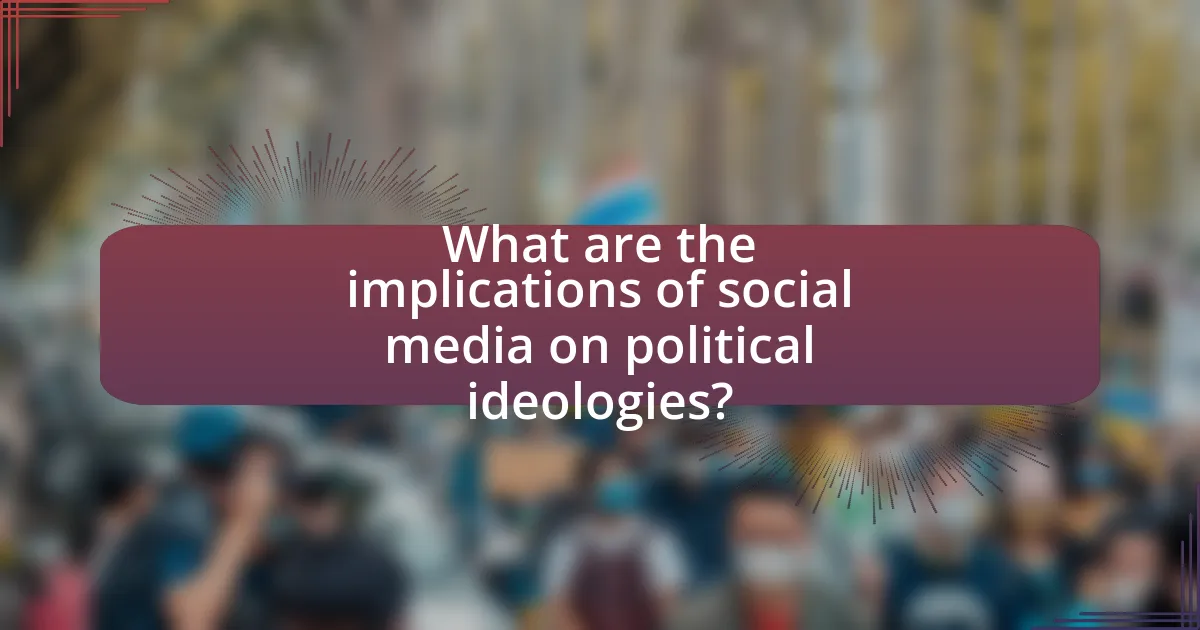
What are the implications of social media on political ideologies?
Social media significantly influences political ideologies by facilitating the rapid dissemination of information and enabling the formation of echo chambers. This platform allows individuals to connect with like-minded people, reinforcing their beliefs and potentially polarizing political views. Research indicates that social media algorithms prioritize content that aligns with users’ existing preferences, which can lead to a narrowed perspective on political issues. For instance, a study by the Pew Research Center found that 64% of Americans believe social media has a mostly negative effect on the way things are going in the country, highlighting concerns about misinformation and divisive content. Additionally, social media serves as a tool for political mobilization, allowing movements to gain traction quickly, as seen in events like the Arab Spring, where platforms like Twitter and Facebook played crucial roles in organizing protests and spreading awareness.
How does social media contribute to polarization in politics?
Social media contributes to polarization in politics by facilitating echo chambers where users are exposed primarily to viewpoints that reinforce their existing beliefs. Algorithms used by platforms like Facebook and Twitter prioritize content that aligns with users’ preferences, leading to a lack of exposure to diverse perspectives. Research by the Pew Research Center indicates that individuals who engage with politically homogeneous groups online are more likely to adopt extreme positions, as they receive validation from like-minded peers. This environment fosters division and intensifies partisan identities, ultimately contributing to a more polarized political landscape.
What evidence exists to support the link between social media use and political polarization?
Evidence supporting the link between social media use and political polarization includes studies demonstrating that social media platforms facilitate echo chambers, where users are exposed primarily to viewpoints that reinforce their existing beliefs. Research by the Pew Research Center indicates that 62% of Americans get news from social media, which often leads to selective exposure and confirmation bias. Additionally, a study published in the journal “Science” by Bakshy et al. (2015) found that social media algorithms promote content that aligns with users’ political preferences, further entrenching polarization. These findings illustrate how social media not only reflects but also amplifies political divisions in society.
How do online interactions shape offline political behavior?
Online interactions significantly influence offline political behavior by fostering engagement, shaping opinions, and mobilizing action. Social media platforms enable users to share political content, which can lead to increased awareness and discussion of political issues among peers. Research indicates that individuals exposed to political information online are more likely to participate in offline activities such as voting or attending rallies. For instance, a study by Boulianne (2015) published in “Political Communication” found that social media use positively correlates with political participation, demonstrating that online discourse can translate into real-world political engagement.
What challenges does social media present to democratic processes?
Social media presents significant challenges to democratic processes by facilitating the spread of misinformation and enabling echo chambers. Misinformation can distort public perception and influence electoral outcomes, as seen in the 2016 U.S. presidential election, where false information proliferated on platforms like Facebook and Twitter, impacting voter behavior. Additionally, echo chambers reinforce existing beliefs, limiting exposure to diverse viewpoints and polarizing political discourse, which undermines the foundational democratic principle of informed citizen participation. Studies indicate that social media algorithms prioritize sensational content, further exacerbating these issues by promoting divisive narratives over constructive dialogue.
How does misinformation spread on social media platforms?
Misinformation spreads on social media platforms primarily through user engagement, including shares, likes, and comments. When users interact with misleading content, algorithms prioritize this content, increasing its visibility and reach. A study by Vosoughi, Roy, and Aral in 2018 found that false news stories are 70% more likely to be retweeted than true stories, demonstrating the rapid dissemination of misinformation. Additionally, echo chambers and confirmation bias contribute to the spread, as users are more likely to share information that aligns with their pre-existing beliefs, further amplifying false narratives within specific communities.
What measures can be taken to combat misinformation in political contexts?
To combat misinformation in political contexts, implementing fact-checking initiatives is essential. Fact-checking organizations, such as PolitiFact and FactCheck.org, assess the accuracy of political statements and claims, providing the public with verified information. Additionally, social media platforms can enhance their algorithms to prioritize credible sources and flag misleading content, as seen in Facebook’s efforts to reduce the spread of false information through partnerships with third-party fact-checkers. Furthermore, promoting media literacy programs can empower individuals to critically evaluate information sources, which is supported by research indicating that media literacy education significantly improves users’ ability to discern credible information from misinformation.
What best practices can individuals and organizations adopt regarding social media and political ideologies?
Individuals and organizations can adopt best practices such as promoting media literacy, encouraging respectful discourse, and diversifying information sources regarding social media and political ideologies. Promoting media literacy helps users critically evaluate the credibility of information, reducing the spread of misinformation. Encouraging respectful discourse fosters a constructive environment for discussing differing political views, which can lead to more informed and empathetic interactions. Diversifying information sources ensures exposure to a range of perspectives, which can mitigate echo chambers and enhance understanding of complex political issues. These practices are supported by research indicating that media literacy education significantly improves critical thinking skills (Hobbs, 2010, “Digital and Media Literacy: A Plan of Action,” Aspen Institute).
How can users critically evaluate political content on social media?
Users can critically evaluate political content on social media by verifying the credibility of sources, analyzing the context of the information, and cross-referencing facts with reliable outlets. Credible sources often include established news organizations, academic institutions, and verified experts in the field. Context analysis involves understanding the circumstances surrounding the content, such as the timing of the post and the intent behind it. Cross-referencing facts with reliable outlets, such as fact-checking websites like Snopes or PolitiFact, helps confirm the accuracy of the information presented. This methodical approach enables users to discern misinformation and develop a more informed perspective on political issues.
What strategies can organizations use to promote healthy political discourse online?
Organizations can promote healthy political discourse online by implementing strategies such as fostering inclusive dialogue, providing educational resources, and moderating discussions effectively. Fostering inclusive dialogue involves creating platforms where diverse viewpoints are welcomed, which can reduce polarization and encourage understanding among participants. Providing educational resources, such as fact-checking tools and guides on civil discourse, equips users with the knowledge to engage constructively. Effective moderation, including the enforcement of community guidelines that discourage hate speech and misinformation, helps maintain a respectful environment conducive to healthy discussions. Research indicates that platforms with active moderation and educational initiatives see a significant decrease in toxic interactions, thereby enhancing the quality of political discourse online.
